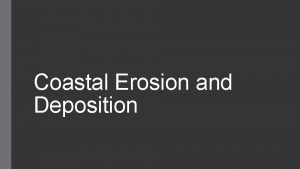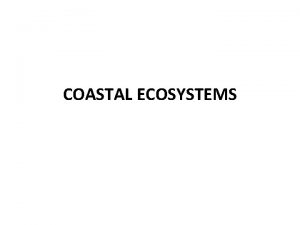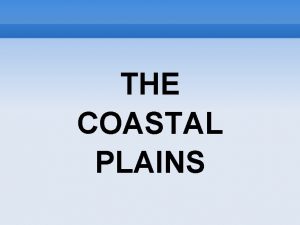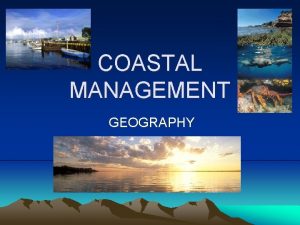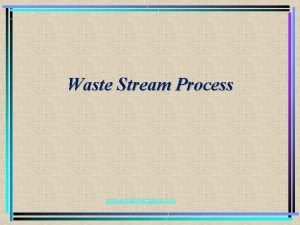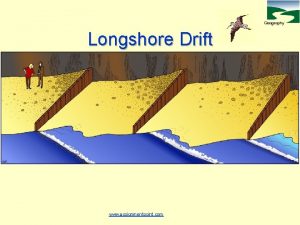Coastal Profile www assignmentpoint com Coastal profile The























- Slides: 23

Coastal Profile www. assignmentpoint. com

Coastal profile The offshore Nearshore Beach Coast www. assignmentpoint. com

Figure 1 www. assignmentpoint. com

Processes responsible for initiating sediment Transportation Changes in water level Tides Waves Currents Stream outflow www. assignmentpoint. com

Coastal response The areas, most directly affected by the forces of the sea are the beaches, the gulfs, and the nearshore zone regions that experience the full impact of the sea’s energy. There are two general types of dynamic beach response to wave motion: Response to normal condition Response to storm condition www. assignmentpoint. com

Normal condition prevail most of the time, and the wave energy is easily dissipated by the beach’s natural defence mechanisms. When storm conditions generates waves containing increased amounts of energy, the coast must respond with extraordinary measures, such as sacrificing large section of beach and dune. Alternate erosion and accretion may be seasonal on some beaches; the winter storm waves erode the beach, and the summer waves rebuilds it. www. assignmentpoint. com

Another nearshore dynamical system is littoral transport - the movement of sediments in the nearshore zone by waves and currents. Littoral transport is divided into two general classes: Longshore transport: Transport parallel to the shore. Onshore-offshore transport: Transport perpendicular to the shore. www. assignmentpoint. com

Modes of Sediment transport Sediments are transported as, Bed load transport The bed load is the part of the total load that is more or less in contact with the bed during the transport. It primarily includes grains that roll, slide or bounce along the bed. experiment and theory suggest that the rate of bedload transport (qb) is proportional to the cube of the shear velocity, i. e. qb ∝ u *3 ………………………. A www. assignmentpoint. com

Suspended load transport. It is the part of the total load that is moving in suspension without continuous contact with the bed. The determination of the rate of suspended load transport is straightforward by comparison with measurement of the rate of bedload transport. Wash load transport It consists of very fine particles transported in water. www. assignmentpoint. com

Figure 2 www. assignmentpoint. com

Longshore drift It is the movement of sediments most often sand, along a coast parallel to its shoreline - a zig-zag movement of sediment along the beach. The largest beach sediment is found where the process begins, updrift, and the smallest, most easily moved, downdrift. Where waves are strong, the coast will be eroded and sediment carried away and where they are weak sediment will be deposited. Longshore drift can have undesirable effects for humans, such as beach erosion. To prevent this, sea defences such as groynes or gabions may be employed. www. assignmentpoint. com

Where beaches have become severely eroded by longshore drift and little material is replaced by natural processes, then the material may be artificially replaced by beach nourishment. Net rate: Gross rate: www. assignmentpoint. com

Model theories for the calculation of longshore drift are Energy flux model Energetic model Suspended transport model www. assignmentpoint. com

Energy flux model It is the simplest model used for the calculation of total amount of material moved along the shoreline. It is based on the amount of energy available in the waves arriving at the shoreline. The flux energy in the wave direction is determined to be as Ϝ dl, where Ϝ -the energy flux of the waves per unit crest width(Ϝ=ECg), E - the energy per unit surface area= ξg. H 2/8 ρ –the water density www. assignmentpoint. com

g-acceleration due to gravity Cg-Group velocity To determine the amount of this energy flux per unit length of coastline consider the figure, www. assignmentpoint. com

dx=dl/cosθ, where θis the angle the wave ray makes with the onshore(y)direction. Now it is supposed that the energy flux in the alongshore direction is responsible for the longshore sediment transport; therefore we multiply the energy flux per unit legth(dx=unity) of beach by sinθ to obtain Ϝcosθsinθ= Pl=ECgsinθcosθ= (ρ g. Cgsin 2θ)/16 www. assignmentpoint. com

For many years this alongshore energy flux per unit length of beach, Pl was correlated empirically with the volume sand moved by the waves. Amount material moved, Q= CPnl. . . . . B Where C is a dimensional constant of proportionality. The power n has been found to be close to unity. equation A as being dimensionally incorrect. Then corrected the equation as Q=KPl/[(ρ s- ρ)g(1 -p)] www. assignmentpoint. com

Where -p is the porosity of the sediment, which is typically about . 3 to . 4. the porosity is introduced to convert sand weight to sad volume, taking into account the voids that occur with in the sand. K-is the dimensionless parameter, its value ranging from 0. 2 to 2. www. assignmentpoint. com

Longshore Sediment transport rate at different locations in India Longshore sediment transport rate (LSTR) reported for different locations along the Indian coast shows local reversals in the transport direction in a number of locations along the west coast. It was found that the annual gross sediment transport rate was high (» 1 * 106 m 3) along the coast of south Orissa and south Kerala. www. assignmentpoint. com

Sediment transport rate at different locations in India Location Net transport Gross transport (m 3/yr) (m 3/yr) West coast of India Kalbadevi 118, 580 South 147, 621 Ambolgarh 189, 594 South 299, 997 Vengurla 53, 040 South 120, 141 Calangute 90, 000 South 120, 000 Colva 160, 000 North 160, 000 Arge 69, 350 North 200, 773 Gangavali 142, 018 South 177, 239 Kasarkod 40, 186 North 77, 502 Maravanthe 25, 372 North 29, 836 www. assignmentpoint. com

Kasargod 736, 772 Kannur 19, 434 Kozhikode 114, 665 Nattika 192, 818 Andhakaranazhi 202, 096 Alleppey 16, 929 Kollam 383, 784 Thiruvananthapuram 99, 159 Kolachel 302, 400 South North South North West www. assignmentpoint. com 958, 478 561, 576 256, 697 660, 276 599, 484 62, 519 805, 296 1231, 153 946, 500

East coast of India Ovari Tiruchendur Kannirajapuram Naripayur Muthupettai Poompuhar Pondichery Periyakalapet Tikkavanipalem Gopalpur Prayagi Puri 1, 500 64, 100 117, 447 36, 600 5, 200 146, 000 134, 400 486, 900 177, 000 830, 046 887, 528 735, 436 South North North North www. assignmentpoint. com 251, 300 87, 500 145, 979 122, 500 8, 900 478, 800 237, 000 657, 600 405, 000 949, 520 997, 594 926, 637

Onshore-offshore transport Cross shore transport is a result of the water motions due to the waves and the undertow. Here the sediment transport is perpendicular to the shore. Important factors in determining the cross-shore transport of sand are The ratio of wave height to wavelength Physical parameters of the beach; i. e. , grain-size distribution, cohesiveness, beach slope also play an important role. www. assignmentpoint. com
 Cơm
Cơm Bài thơ mẹ đi làm từ sáng sớm
Bài thơ mẹ đi làm từ sáng sớm Assignmentpoint.com
Assignmentpoint.com Tetrafluroethene
Tetrafluroethene Assignmentpoint.com bangladesh
Assignmentpoint.com bangladesh Project management functions
Project management functions Www.assignmentpoint.com
Www.assignmentpoint.com Mail @ assignmentpoint.com
Mail @ assignmentpoint.com Unilever sbu
Unilever sbu Www.assignment
Www.assignment Assignmentpoint
Assignmentpoint Assignmentpoint
Assignmentpoint Economic importance of coniferous forest
Economic importance of coniferous forest Assignment point
Assignment point Elasticity formula
Elasticity formula Glibbering
Glibbering Www.assignmentpoint.com
Www.assignmentpoint.com Assignmentpoint.com
Assignmentpoint.com Uml
Uml Www.assignmentpoint.com
Www.assignmentpoint.com Objectives of computer hardware
Objectives of computer hardware Assignmentpoint.com
Assignmentpoint.com Assignmentpoint.com
Assignmentpoint.com Phép trừ bù
Phép trừ bù

























